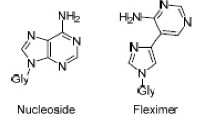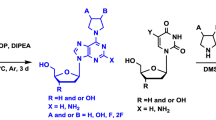Abstract
Theoretically, inosine analogues should act as effective inhibitors of tumor cell proliferation and viral replication. To acquire a broad spectrum of new candidate inosine analogues, a rapid, facile, quantitative and stereoselective method for deaminating potential antitumor and antiviral adenine analogues previously synthesized in our laboratory was developed. A novel 5′-adenylic acid deaminase, with relaxed substrate requirements, fromAspergillus species was utilized to deaminate four hexofuranosyladenine nucleosides and five adenine nucleoside dialdehydes to their corresponding inosine analogues. The fastest rates of deamination for the hexofuranosyl nucleosides were for the compounds where the vicinal hydroxyl groups on the sugars are oriented in the erythro configuration. For rapid deamination of the adenine nucleoside dialdehydes, theR configuration at the proximal carbon atom is preferred, while the nature of the group on the distal carbon atom has no significant effect on the rate or extent of deamination.
Similar content being viewed by others
Literatur
Bessman M. J., Lehman I. R., Adler J., Zimmerman S. B., Simms E. S. and Kornberg A. (1958) Enzymatic synthesis of deoxyribonucleic acid. III. The incorporation of pyrimidine and purine analogues into deoxyribonucleic acid. Proc. Natl Acad. Sci. USA44: 633–640
Feix G. (1976) Primer-dependent copying of rabbit globin mRNA with Qp replicase. Nature259: 593–594
Kahan Y-M. and Hurwitz J. (1962) The role of deoxyribonucleic acid in ribonucleic acid synthesis. IV. The incorporation of pyrimidine and purine analogues into ribonucleic acid. J. Biol. Chem.237: 3778–3785
Shapiro L. and August J. T. (1965) Replication of RNA viruses. III. Utilization of ribonucleotide analogues in the reaction catalyzed by a RNA virus polymerase. J. Mol. Biol.14: 214–220
Miles H. T. (1961) Tautomeric forms in a polynucleotide helix and their bearing on the structure of DNA. Proc. Natl Acad. Sci. USA47: 791–802
Lerner L. M. (1973) Interconversions of hexofuranosyl nucleosides II. Preparation of 9-α-l-idofuranosyladenine and 5′-6′-unsaturated derivatives. J. Org. Chem.37: 473–477
Lerner L. M. (1973) Interconversions of hexofuranosyl nucleosides. V. Synthesis and reexamination of the structure of 9-(6-deoxy-α-l-mannofuranosyl) adenine. J. Org. Chem.38: 3704–3709
Lerner L. M. (1976) Adenine nucleosides derived from 6-deoxyhexofuranoses. J. Org. Chem.41: 306–310
Lerner L. M. and Mennitt G. (1994) A new synthesis ofl-talose and preparation of its adenine nucleosides. Carbohydr. Res.259: 191–200
Lerner L. M., Sheid B. and Gaetjens E. (1987) Preparation and antileukemic screening of some new 6′-deoxyhexopyranosyladenine nucleosides. J. Med. Chem.30: 1521–1525
Corey J. C., Mansell M. M. and Whitford T. W. Jr. (1976) Inhibition of ribonucleotide reductase activity and nucleic acid synthesis in tumor cells by the dialdehyde derivative of inosine and inosinic acid. Cancer Res.36: 3166–3170
Cysyk R. L. and Adamson R. H. (1974) Antitumor properties and pharmacological disposition of inosine dialdehyde. Proc. Am. Assoc. Cancer Res.15: 56
Kaufman J. and Mittleman I. (1975) Clinical phase 1 trial of inosine dialdehyde (NSC 118994). Cancer Treat. Rep.59: 1007–1110
Sheid B., Saggar M., Gaetjens E. and Lerner L. M. (1991) Antiproliferative activity of purine nucleoside dialdehydes against leukemia L1210 in vitro. Cancer Chemother. Pharmacol.28: 339–343
Jackson R. C. (1984) A kinetic model of regulation of the deoxyribonucleoside triphosphate pool composition. Pharm. Ther.24: 279–301
Srivastava V. K., Pall M. L. and Schroeder A. L. (1988) Deoxyribonucleotide triphosphate pools inNeurospora crassa: effects of histidine and hydroxyurea. Mutat. Res.200: 45–53
Kalckar H. M. (1947) Differential spectrophotometry of purine compounds by means of specific enzymes II. Determination of adenine compounds. J. Biol. Chem.167: 445–459
Wnuk S. F., Stoeckler J. D. and Robins M. J. (1994) Nucleic acid related compounds. 82. Conversion of adenosine to inosine 5′-thioether derivatives withAspergillus oryzae adenosine deaminase or alkylnitrites. Substrate and inhibitor activities of inosine 5′-thioether derivatives with purine nucleoside phosphorylase. Nucleosides and Nucleotides13: 389–403
Grosshans J. and Wolfenden R. (1993) Transition-state discrimination by adenosine deaminase fromAspergillus oryzae. Biochim. Biophys. Acta1161: 28–32
Wolfenden R., Sharpless T. K. and Allan R. (1967) Substrate binding by adenosine deaminase: specificity, pH dependence and competition by mercurials. J. Biol. Chem.242: 977–983
Mitchell H. K. and McElroy W. D. (1946) Adenosine deaminase fromAspergillus oryzae. Arch. Biochem.10: 351–358
Margolin A. L., Borcherding D. R., Wolf-Kugel D. and Margolin N. (1994) AMP deaminase as a novel practical catalyst in the synthesis of 6-oxopurine ribosides and their analogues. J. Org. Chem.59: 7214–7218
Yarchoan R., Mitsuya H., Thomas R. V., Pluda J. M., Harmon N. R., Perno C-F, Marczyk K. S., Allain J. P., John D. and Broder S. (1989) In vivo activity against HIV and favorable toxicity profile of 2′-3′-dideoxyinosine. Science245: 412–415
Author information
Authors and Affiliations
Rights and permissions
About this article
Cite this article
Sheid, B., Gaetjens, E., Chung, S.T. et al. Enzymatic formation of potential anticancer and antiviral inosine analogues. Experientia 52, 878–881 (1996). https://doi.org/10.1007/BF01938874
Received:
Revised:
Accepted:
Issue Date:
DOI: https://doi.org/10.1007/BF01938874




